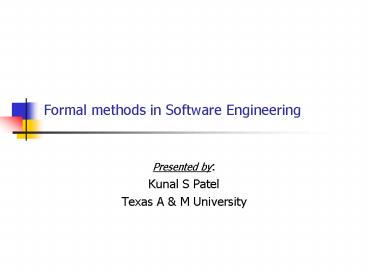Formal methods in Software Engineering PowerPoint PPT Presentation
1 / 16
Title: Formal methods in Software Engineering
1
Formal methods in Software Engineering
- Presented by
- Kunal S Patel
- Texas A M University
2
Outline
- Concept and evolution
- Some Definitions
- Example using formal method
- Selection criteria and guidelines for use
- Conclusion
3
Concept
- Current methods of software development involves
only combination of diagrams, text, tables etc. - No methods are used to test the correctness of
the end result in each of stages of software
development for e.g. requirement specification,
design etc. - This may lead to contradictions, ambiguities,
incompleteness, vagueness etc. - This may not be a good option for safety-critical
or mission critical systems,where failure may
have high price
4
Concept
- Formal methods allow a software engineer to
create a specification that is more consistent
and unambiguous - Set theory and logic notations are used to create
a clear statement of facts (requirements) which
can then be analyzed to prove correctness and
consistency - Since specification is created using mathematical
notation, it is inherently less ambiguous than
informal modes of representation.
5
Definitions
- Data Invariant
- A data invariant is a condition that is true
throughout the execution - of the system that contains a collection of data.
E.g. maximum - number elements in any system, duplication not
allowed in a - system.
- State
- A state is the stored data that a system accesses
and alter.
6
Definitions
- Operation
- It is defined as action that takes place in a
system and reads or - writes data to a state
- It is associated with 2 conditions
- Precondition
- Postcondition
- Precondition defines whether the operation is
valid or not and - Postcondition defines what happens when an
operation has - completed its action
7
Example
- Block Handler
- A common part of any operating system which
handles the - memory blocks
- Provides free blocks of memory to new created
files and regains blocks when file is removed. - It keeps tracks of free blocks or the unused
blocks and the used blocks - Whenever a block is freed, it is added to the
queue of unused blocks and similarly whenever a
block is needed first block from the queue of
unused bock is given for use.
8
Block Handler
- Mathematical Definition of state, data invariant
and operation for such system will be as follows - State
- Collection of free blocks, collection of used
blocks, and the queue of returned blocks.
Mathematically they are defined as - used, free P BLOCKS
- BlockQueue seq P BLOCKS
9
Block Handler
- Data Invariant
- No block will be marked as both unused and used
- used ? free 0
- The collection of used blocks and blocks that are
unused will be the total collection of blocks
that make up the files - used U free ALLBLOCKS
10
BLOCK Handler
- Operations
- Operation for removing block from the queue
- Precondition
- BLOCKQUEUE gt 0
- Postcondition
- used used BLOCKQUEUE blocks(used)
- free free BLOCKQUEUE blocks(used)
11
Selection criteria
- Factors that should be taken into consideration
while using formal methods are as follows - Estimate Cost
- Formal methods have high start up cost. Training
staff, acquisition of support tools and use of
contract consultants results in high first time
cost - Use formalization and not over formalization
- It is not necessary to apply formal methods to
every aspects of a major system. Components that
are safety critical should only be built using
formal methods
12
Selection criteria
- Integration
- It is possible to integrate and in many cases
desirable, to integrate formal methods with
conventional or object oriented methods. A
combination, if properly applied, can produce
excellent results - Should maintain quality standards
- SQA activities must continue to be applied as
systems are developed
13
Selection criteria
- One should not be dogmatic
- Formal methods are not a guarantee of
correctness. It is possible that the final
system, even when developed using formal methods,
may have small omissions, minor bugs, and other
attributes that do not meet expectations - Test, Test and Test again
- Formal methods do not absolve the software
engineer from the need to conduct well planned,
thorough tests
14
Discussion
- The previous example shows the value of using
formal method for specifying requirements - Requirements specified by using such mathematical
formulations decreases the ambiguity and makes
the system consistent - Though very attractive in use, they are used only
in certain domain of application due to its
complexity and time consuming nature - Most suitable applications are mission critical
where domain of error has to be reduced to
minimum before using the system
15
Discussion
- Other certain major disadvantages of formal
methods are follows - It only focuses on function and data. Timing,
control, and behavioral aspects of a problem are
more difficult to represent - Some elements of a problem(e.g. human/machine
interface) are better specified using graphical
techniques or prototypes - Specification using formal methods is more
difficult to learn and represents a significant
culture shock for some software practitioners
16
Conclusion
- Formal methods are attractive option for building
system which are mission critical - It provably argues the correctness of the system.
It removes ambiguity and vagueness from the
system - But they are often hard to incorporate in todays
world where deadlines are to be met - Also requires lot of start up cost which may not
be desirable for many applications

